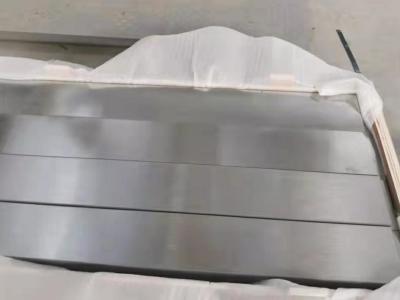Description
Scope of supply for Aviation Group
Forgings, round rods, steel plates, rings, seamless pipes, steel plates/steel belts, capillaries, wire welding materials, welcome to inquire!
Titanium forgings. Custom
titanium rods according to the drawings. Φ(8-400) ×L≤5000mm (rolled rods, forged rods)
titanium plate/belt (0.3-60.0) × (400-1000) × (1000-3500) mm (cold rolled plate, hot rolled plate)
titanium tube Φ(3-210) × (0.2-10.0) ×L (rolled pipes, extruded pipes)
titanium ring Outer diameter φ(100-1200) × inner diameter Φ(100-1000) × height (20-800) mm
titanium round cake Φ(150-1200) × (20-800) mm
titanium wire Φ(0.1-7.0) ×L
- Introduction to Ti-6Al-4V materials
The composition of TC4 material of titanium alloy is Ti-6Al-4V, which belongs to the (α+β) type titanium alloy. TC4 titanium alloy is an alloy composed of titanium-based aluminum and vanadium. It has the advantages of low density, high specific strength, good corrosion resistance and good process performance, and has good comprehensive mechanical properties. It is an ideal structural material for aerospace engineering. Higher strength. The strength of TC4 is sb=1.012GPa, the density g=4.51g/cm3, the specific strength of sb/g=23.5, while the specific strength of alloy steel is less than 18.
- Ti-6Al-4Vchemical composition
| Brand number | Chemical composition (weight percentage) | |||||||||||
| Chemicai composition(WT%) | ||||||||||||
| Ti-6al-4V | Chemical Ingredients | titanium | iron | carbon | nitrogen | hydrogen | oxygen | aluminum | vanadium | Other impurities | ||
| (Of) | (Fe) | (C) | (N) | (H) | (O) | (Al) | (V) | single | sum | |||
| Industrial pure titanium | margin | ≤0.30 | ≤0.10 | ≤0.05 | ≤0.015 | ≤0.25 | 5.5~6.8 | 3.5~4.5 | ≤0.10 | ≤0.40 | ||
- Ti-6Al-4Vphysical properties
Ti-6Al-4V titanium alloy density: 4.5 (g/cm3) working temperature -100~550 (℃)
| Brand number | Room temperature mechanical properties are not less than | High temperature mechanical properties are no less than | ||||||
| Tensile strength σb MPa | Yield strength σ0.2MPa | Elongation δ5% | Shrinkage ψ % | Impact value αk J/cm 2 | Test temperature ℃ | Tensile strength σb MPa | Long-lasting strength σ100 MPa | |
| TC1 | 588 | — | 15 | 30 | 44.1 | 350 | 343 | 324 |
| TC2 | 686 | — | 12 | 30 | 39.2 | 350 | 422 | 392 |
| Ti-6al-4V | 902 | 824 | 10 | 30 | 39.2 | 400 | 618 | 569 |
| TC6 | 981 | — | 10 | 23 | 29.4 | 400 | 736 | 667 |
| TC9 | 1059 | — | 9 | 25 | 29.4 | 500 | 785 | 588 |
| TC10 | 1030 | — | 12 | 25~30 | 34.3 | 400 | 834 | 785 |
| TC11 | 1030 | — | 10 | 30 | 29.4 | 500 | 686 | 588 |
- Technical standards of Ti-6Al-4V materials
GB/T3620.1-2016 Titanium and Titanium Alloy Grades and Chemical Compositions
GB/T 3621-2007 ASTM/B265 Titanium and Titanium Alloy Sheet
GB/T2965 -2007 ASTM/B348 Titanium and Titanium Alloy Rod Material
GB/T 3624-2010 ASTM337 Titanium and Titanium Alloy Seamless Tube
GB/T16598-2013 Titanium and titanium alloy tubes for ASTM381 heat exchanger and condenser
GB/T13810-1997 Titanium and titanium alloy processing materials for AMST/F136 surgical implants
GB/T3623-2007 AMST/B863 titanium and titanium alloy wire
AMST/B265 ASTM/B265 Titanium and Titanium Alloy Band·Foil
Ti-6Al-4V heat treatment performance
The Ti-6Al-4V titanium alloy is heated to 1020 degrees, and the alloy’s high-temperature microstructure is composed of single-phase β, which is a solid solution. When the microstructures obtained are different at different cooling rates, such as water quenching, air cooling and furnace cooling, the microstructure obtained is different. The water quenching (WQ) structure is martensite α’+β phase, the air cooling (AC) structure is needle-shaped α+β phase and original β grain boundary phase, and the furnace cooling (FC) structure is strip-shaped α+β phase and original β phase grain boundary.
As in the above case, when heated to 950 degrees and 850 degrees, the microstructure obtained after cooling is also different after different cooling speeds. At 950 degrees, the quenched (WQ) tissue in water is the primary equiaxed α phase and α’+β phase, the air-cooled (AC) tissue is the primary equiaxed α phase and the needle-shaped β phase, and the furnace-cooled (FC) tissue is the primary equiaxed α phase and the grain boundary. At 850 degrees, the quenched (WQ) tissue in water is the primary equiaxed α phase and the metastable β phase, and the air-cooled (AC) tissue is the primary equiaxed α phase and the transformed β phase.
After heating Ti-6Al-4V titanium alloy to 1020 degrees, 950 degrees and 850 degrees, it cools at different cooling speeds. The room temperature mechanical properties are shown in Table 1
| Heating temperature and cooling method | Tensile strength/Mpa | Elongation/% | Surface shrinkage rate/% |
| 1020 degrees Swimming (WQ) | 1098 | 6.0 | 8.0 |
| 1020 degree air cooling (AC) | 1005 | 9.0 | 13.5 |
| 1020 degrees furnace cooling (FC) | 960 | 12.0 | 22.5 |
| 950 degrees Swimming (WQ) | 1035 | 17.0 | 61.5 |
| 950 degree air cooling (AC) | 919 | 20.0 | 50.0 |
| 950 degree furnace cooling (FC) | 902 | 21.0 | 48.0 |
| 850 degrees Swimming (WQ) | 976 | 18.0 | 49.0 |
| 850 degree air cooling (AC) | 951 | 18.0 | 49.0 |
- Ti-6Al-4Vapplication field
- It is mainly used in aircraft compressor discs and blades, ship pressure-resistant shells, large-size forgings, die forgings, etc.;
- Used to manufacture rockets, missiles and aircraft structural parts, aircraft skeletons, skins, engine components, beams, etc.;
- Pipeline systems, valves, and pumps that are corroded by marine seawater;
- Power station condensers, accelerators for petroleum refining and seawater desalination, and environmental pollution control devices, etc.;
- Chemical heat exchanger, pump body, distillation tower;
- Widely used in medical devices

